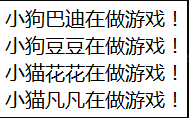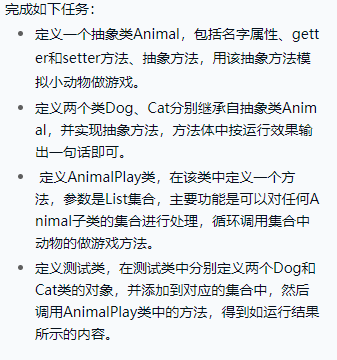# 泛型
[TOC]
## 導學
在之前學過的集合框架中,List和Map都使用了泛型技術來確認其內容的數據類型。
如果不使用泛型,在程序運行階段,會帶來數據類型轉型的錯誤風險。
~~~
List<String> list = new ArrayList<String>();
list.add("tom");
for (int i = 0; i < list.size(); i++) {
String obj = list.get(i);
System.out.println(obj);
}
List list2 = new ArrayList();
list2.add("helen");
list2.add(2); // 自動裝箱成Integer
list2.add(true); // 自動裝箱成Boolean
for (int i = 0; i < list2.size(); i++) {
String obj = (String)list2.get(i); // 此處是有風險的
}
~~~
在Java中,使用變量之前,必須要先定義變量的數據類型,存在一種特殊的現象,就是多態(數據類型是父類,實現對象是子類),變量賦值不一定要完全和數據類型一致,可以賦予子類對象給它。
~~~
public class Client2 {
public static void main(String[] args) {
Point point = new Point();
point.x = "東經102°";
point.y = "北緯32°";
point.x = 102;
point.y = 32;
String s = (String) point.x;
point.print();
}
}
class Point {
Object x;
Object y;
public void print() {
System.out.println(x + "" + y);
}
}
~~~
>[danger]向下轉型會帶來數據風險的(ClassCastException)
不使用泛型的缺點:需要強制轉換;可向集合中添加任意類型的對象,存在風險
泛型的使用:在接口/類名后的尖括號內加上類型,如 `List list=new ArrayList(); `同時,變量聲明時的泛型類和其實現類時的泛型類必須相同,即“=”前后的尖括號中的類型需要一致
~~~
class Animal{}
class Cat extends Animal {}
List<Animal> list = new ArrayList<Cat>();
這樣是不允許的。變量聲明的類型必須匹配傳遞給實際對象的類型
~~~
## 泛型作為方法參數
**泛型作為方法參數**
>[info] 案例:
> 定義一個抽象類Goods,包含抽象方法sell();
> 分別定義各類商品Book,Clothes和Shoes繼承Goods,并實現sell()方法,輸出一句話,如sell books
> 定義一個商品銷售類GoodsSeller,模擬銷售,包括方法:public void sellGoods(List goods),循環調用list對象的sell() 方法
~~~
public abstract class Goods {
public abstract void sells();
}
public class Books extends Goods{
@Override
public void sells() {
System.out.println("sell books");
}
}
public class Clothes extends Goods {
@Override
public void sells() {
System.out.println("sell clothes");
}
}
public class Shoes extends Goods {
@Override
public void sells() {
System.out.println("sell shoes");
}
}
public class GoodsSeller {
//代表只要goods參數保存的元素是Goods或者Goods的子類,都可以
public void sellGoods(List<? extends Goods> goods) {
//調用集合中的sell方法
for(int i = 0; i < goods.size(); i++) {
Goods g = goods.get(i);
g.sells();
}
}
}
public class Test {
public static void main(String[] args) {
//定義books相關的list
List<Books> bookLst = new ArrayList<Books>();
bookLst.add(new Books());
bookLst.add(new Books());
//定義Shoes相關的list
List<Shoes> shoesLst = new ArrayList<Shoes>();
shoesLst.add(new Shoes());
shoesLst.add(new Shoes());
//定義Clothes相關的list
List<Clothes> clothesLst = new ArrayList<Clothes>();
clothesLst.add(new Clothes());
clothesLst.add(new Clothes());
GoodsSeller gdSeller = new GoodsSeller();
gdSeller.sellGoods(bookLst);
}
}
~~~
## 自定義泛型類
~~~
public class Demo {
public static void main(String[] args) {
Point<Integer, Integer> p = new Point<Integer, Integer>();
p3.x = 1;
p3.x = 2;
}
}
public class Point<T1, T2> {
T1 x;
T2 y;
}
~~~
>[warning] 類的泛型在className之后定義,只有定義的泛型類型才能在類中使用。
即我們定義只有先定義類名后的泛型標志符的時候,才能使該泛型類使用泛型定義方法和成員變量。
## 自定義泛型方法
>[success] 泛型方法不一定要寫在泛型類中
~~~
/**
* 定義泛型方法
**/
public class GenericMethod {
//定義泛型方法的時候需要將泛型放在訪問修飾符和返回值中間
public <T extends Number> void print(T t) {
System.out.println(t.toString());
}
public static void main(String[] args) {
GenericMethod gm = new GenericMethod();
//可以通過泛型方法實現一個方法傳遞不同的參數
//gm.print("123");規定泛型的繼承限定之后,該行語句就是錯誤的了
gm.print(123);
gm.print(123f);
}
}
~~~
>[warning] 泛型一般使用于框架設計,在實際的應用開發中較少運行
## Java泛型中的標記符含義:
E - Element (在集合中使用,因為集合中存放的是元素)
T - Type(Java 類)
K - Key(鍵)
V - Value(值)
N - Number(數值類型)
? - 表示不確定的java類型
`<K,V>`就是代表鍵值對的泛型
## 練習
一、選擇
1. 以下語句正確的是:(多選)
~~~
A. List<String> list=new ArrayList<String>();
B. List<Integer> list=new ArrayList<>();
C. 已知Cat是Animal類的子類,則List<Animal> list=new ArrayList<Cat>();
D. List<Object> list=new ArrayList<Integer>();
~~~
二、編程
1. 通過練習,掌握泛型作為方法參數的應用,具體內容見任務要求。運行效果如下:

任務:

